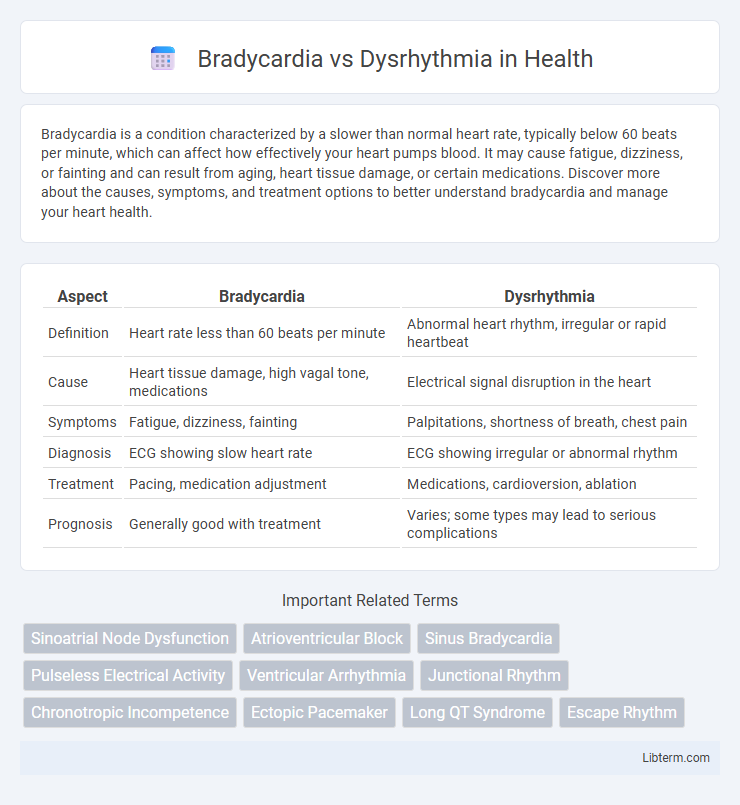Bradycardia is a condition characterized by a slower than normal heart rate, typically below 60 beats per minute, which can affect how effectively your heart pumps blood. It may cause fatigue, dizziness, or fainting and can result from aging, heart tissue damage, or certain medications. Discover more about the causes, symptoms, and treatment options to better understand bradycardia and manage your heart health.
Table of Comparison
| Aspect | Bradycardia | Dysrhythmia |
|---|---|---|
| Definition | Heart rate less than 60 beats per minute | Abnormal heart rhythm, irregular or rapid heartbeat |
| Cause | Heart tissue damage, high vagal tone, medications | Electrical signal disruption in the heart |
| Symptoms | Fatigue, dizziness, fainting | Palpitations, shortness of breath, chest pain |
| Diagnosis | ECG showing slow heart rate | ECG showing irregular or abnormal rhythm |
| Treatment | Pacing, medication adjustment | Medications, cardioversion, ablation |
| Prognosis | Generally good with treatment | Varies; some types may lead to serious complications |
Introduction to Bradycardia and Dysrhythmia
Bradycardia is a condition characterized by an abnormally slow heart rate, typically fewer than 60 beats per minute, which can reduce blood flow and oxygen delivery to the body. Dysrhythmia, also known as arrhythmia, refers to any irregularity or abnormality in the heart's rhythm, including conditions where the heart beats too fast, too slow, or erratically. Both bradycardia and dysrhythmia disrupt normal cardiac function, potentially leading to symptoms such as dizziness, fatigue, and, in severe cases, sudden cardiac arrest.
Defining Bradycardia: Key Characteristics
Bradycardia is characterized by a heart rate below 60 beats per minute, often caused by aging, heart disease, or medication effects. Unlike dysrhythmia, which refers to irregular heartbeats that can be either fast or slow, bradycardia specifically denotes a slower-than-normal rhythm. Key clinical features include fatigue, dizziness, and fainting, highlighting its impact on cardiovascular efficiency.
Understanding Dysrhythmia: Types and Features
Dysrhythmia refers to any abnormal heart rhythm, encompassing a variety of types such as atrial fibrillation, ventricular tachycardia, and bradycardia, each with distinct electrophysiological features. Bradycardia is a specific type of dysrhythmia characterized by a slower than normal heart rate, typically below 60 beats per minute, which can lead to fatigue, dizziness, or more severe complications. Understanding the mechanisms and clinical presentations of different dysrhythmias is critical for accurate diagnosis and tailored treatment strategies to restore normal cardiac rhythm and function.
Causes of Bradycardia
Bradycardia, characterized by a heart rate below 60 beats per minute, often results from intrinsic causes such as sinoatrial node dysfunction, heart block, or ischemic heart disease. External factors including hypothyroidism, electrolyte imbalances, and the use of beta-blockers or calcium channel blockers can also induce bradycardia. Unlike dysrhythmia, which encompasses any irregular heart rhythm, bradycardia specifically refers to the slow heartbeat primarily caused by abnormalities in the heart's electrical conduction system.
Common Causes of Dysrhythmia
Dysrhythmia, or arrhythmia, commonly arises from conditions such as ischemic heart disease, electrolyte imbalances, and structural heart abnormalities like cardiomyopathy. Unlike bradycardia, which specifically refers to a slow heart rate often caused by aging or medication side effects, dysrhythmia encompasses a broader range of irregular heart rhythms including tachycardia and fibrillation due to these underlying factors. Identifying and addressing triggers like coronary artery disease, hypokalemia, and myocardial scar tissue is crucial for effective management of dysrhythmias.
Symptoms Comparison: Bradycardia vs Dysrhythmia
Bradycardia is characterized by a slow heart rate, often resulting in fatigue, dizziness, and fainting due to inadequate blood flow. Dysrhythmia encompasses irregular heart rhythms, which can cause palpitations, chest pain, shortness of breath, and sometimes syncope. While bradycardia primarily involves a reduced heart rate, dysrhythmia includes both fast and irregular heart rates with a broader range of symptomatic presentations.
Diagnosis Techniques for Bradycardia and Dysrhythmia
Diagnosis of bradycardia primarily involves electrocardiogram (ECG) monitoring to track heart rate and rhythm abnormalities, often supplemented by Holter monitoring for continuous assessment. Dysrhythmia diagnosis relies on ECG as well, with event recorders and electrophysiological studies used to detect intermittent arrhythmias and to map electrical conduction pathways. Both conditions benefit from echocardiography to evaluate structural heart issues that may contribute to abnormal rhythms.
Treatment Options for Bradycardia
Treatment options for bradycardia primarily include the use of medications such as atropine to increase heart rate and the implantation of a pacemaker to maintain adequate cardiac rhythm in severe cases. Lifestyle modifications and addressing underlying conditions like hypothyroidism or electrolyte imbalances also play a crucial role in management. In some cases, temporary pacing or adjusting current therapies might be necessary depending on the patient's overall health and response to initial treatments.
Managing Dysrhythmia: Therapeutic Approaches
Managing dysrhythmia involves a combination of pharmacological treatments such as antiarrhythmic drugs, beta-blockers, and calcium channel blockers to regulate heart rhythm. Advanced therapeutic approaches include catheter ablation, which targets and destroys abnormal electrical pathways, and implantable devices like pacemakers and defibrillators to maintain proper cardiac function. Continuous monitoring through Holter monitors or electrophysiological studies is essential to tailor treatment and prevent complications associated with dysrhythmia.
Prognosis and Complications: A Comparative Overview
Bradycardia, characterized by an abnormally slow heart rate below 60 beats per minute, generally has a favorable prognosis when caused by physiological conditions or treated effectively but can lead to complications such as syncope, heart failure, or sudden cardiac arrest if untreated. Dysrhythmia, encompassing a wide range of abnormal heart rhythms including atrial fibrillation and ventricular tachycardia, carries a variable prognosis depending on type and severity, with potential complications like stroke, myocardial infarction, or progressive heart failure. Early diagnosis and management through medications, lifestyle modifications, or interventions such as pacemakers or ablation vastly influence long-term outcomes for both conditions.
Bradycardia Infographic

 libterm.com
libterm.com